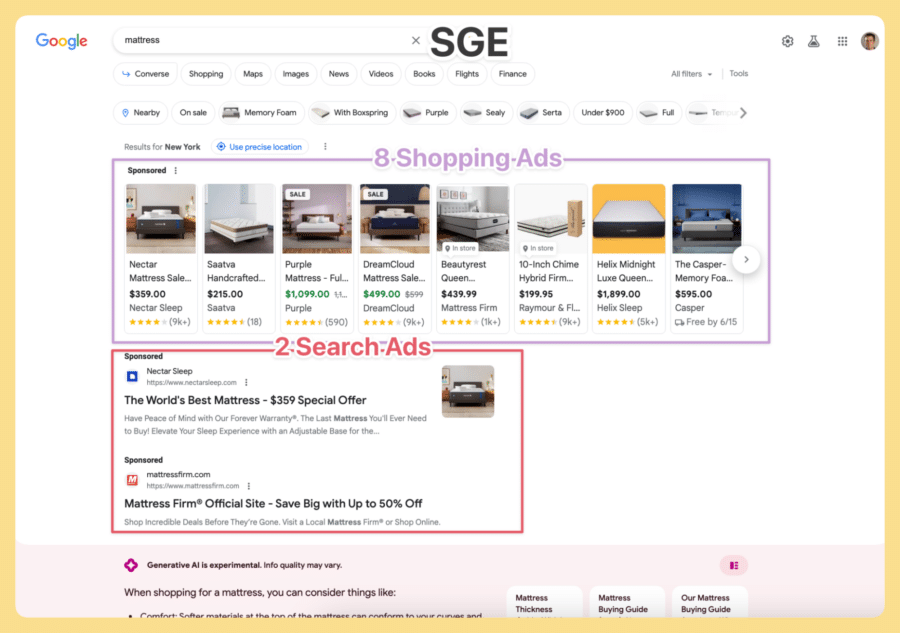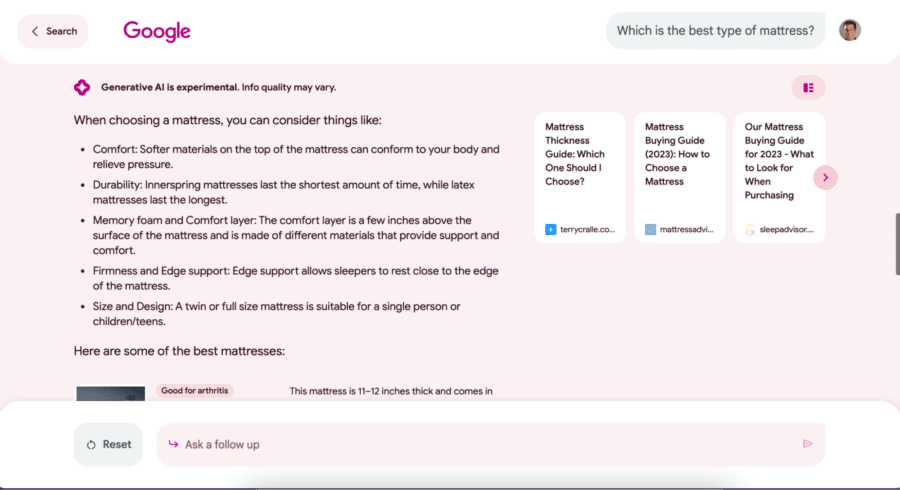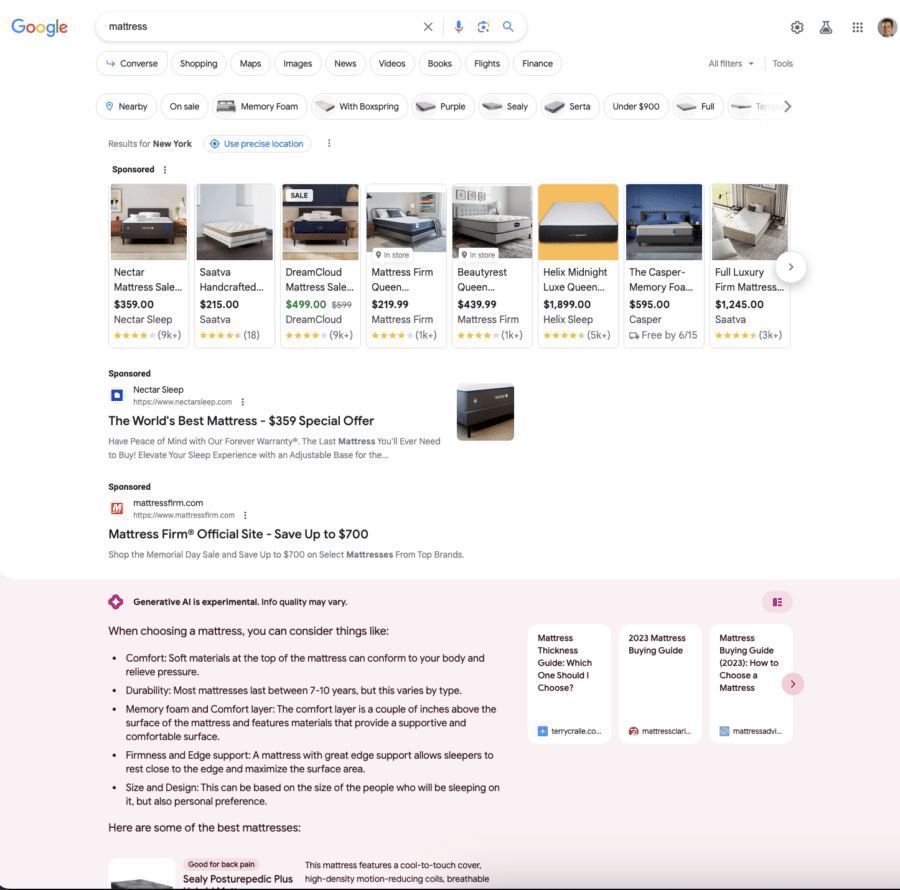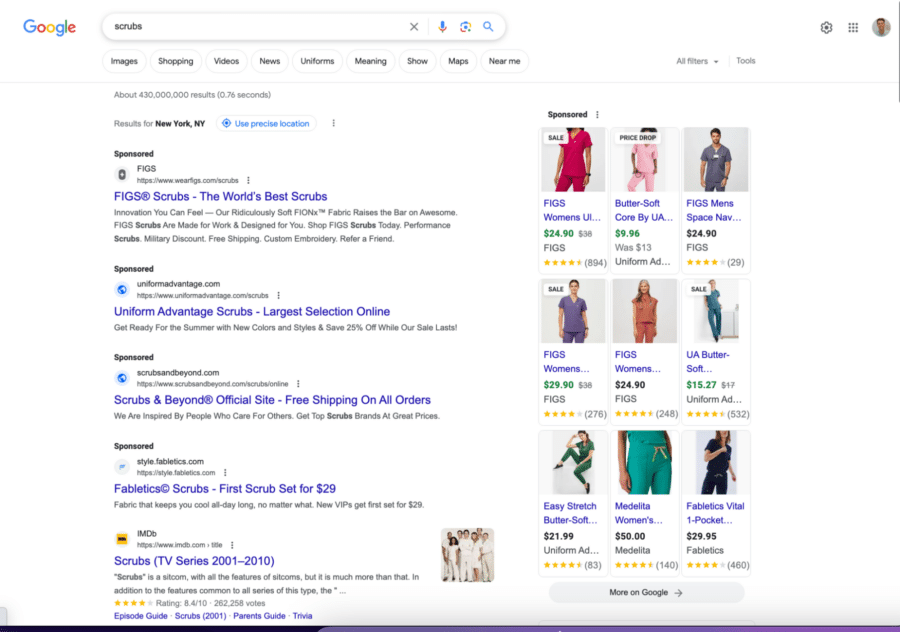For the past 25 years, Google’s been making our lives much easier by consistently delivering user-friendly platforms and innovative technology. And as all true Google fans know, they’re always one step ahead of everyone in the AI game.
Less than two months ago, Google introduced its latest Search Labs innovation in generative AI – Search Generative Experience, commonly known as SGE.
In a nutshell, SGE is a collection of interface and search capabilities that integrate generative AI results into Google search responses. And if you were looking for Google to deploy generative AI to create sophisticated ad campaigns, look no further.
They’ve done it, at least to a certain level.
This brand-new feature is user-friendly, and on top of that, it’s available to download for your desktop computer and laptop via Chrome and as a mobile app for iOS and Android.
In this article, I’ll introduce you to ads and ad placements in Google’s SGE, but first, let’s briefly define SGE and its AI-powered nature.
Table of Contents
What Does Google Search Generative Experience Stand For?
Google SGE, previously known as Project Magi, is a brand-new experimental feature that generates answers with the help of AI. Its primary focus is to provide personalized results and insights to users worldwide.
SGE uses the benefits of Google AI to improve its users’ search experience in three ways:
- Conversational mode: It answers additional questions while remembering the first question and its context.
- AI snapshot: It provides users with summarized answers for long and complex queries.
- Vertical experiences: It gives users a list of their most-preferred features and shows them details about some products that they’re searching for via Google.
What truly makes Google search generative experience unique is that it doesn’t rely only on the indexed and ranked data available in Google’s algorithm. It also uses the Pathways Language Model (PaLM 2), a sophisticated LLM, which stands for a large language model.
Now that you know what this innovative AI technology is, let me show you how to create ads with Google Search Generative Experience.
Ads in Google Search Generative Experience
I was interested to find out the main highlights of Google Ads in SGE, so I made a short list of the observations that I personally found most important:
- No New Ad Formats (Yet)
At the time of writing this article, there are no new ad formats.
The ad formats in Google Search Generative Experience look the same as those appearing when you do a regular Google search.
- Absence of Ads in the Chat Mode
When you go into the questions section, the user interface changes and resembles a chat mode. The first thing you might notice once you’re in the chat mode is that there are no ads.
Not a single Search or a Shopping ad.
- Reduction in The Overall Number of Ads
The amount of ads you get in SGE is slightly smaller than the amount you get when you do a regular Google search.
Is Google Search Generative Experience Available on Mobile?
There’s information on Google that it’s available for Android phones. You must download the Google App Google Search, be at least 18 years old (SGE is not allowed for minors), and have a private Google Account.
SGE is not available for Google Workspace.
At this phase, SGE is only available to a limited number of individuals based in the United States and is available only in English.
Ad Placements in Google Search Generative Experience
I finally got access to Google’s Search Generative Experience and wanted to see how it works and its main features.
So, I browsed through the search results and observed some ad placements.
Here’s what I found about ad placements in SGE that caught my eye.
SGE Ad Placements Features
First, let’s see an example of how an ecommerce search and the ads look like in SGE.
An Example of an E-Commerce Search and Ad Placements
I wanted to learn how ads are placed in a popular ecommerce search. So, I googled “Mattress.”

You can see that the ads look pretty much the same as the regular Google Search results. There are “Extras,” and you can enter the “Chat Mode.”
Google Shopping Ads and Limited Generative Content
Once you scroll down after the initial few ads, you’ll notice two text ads. The content is a bit limited as you can see from the screenshot below.

After the text ads, you’ll see the generative part, where you get tips on what you see.
For example, when googling the word “mattress,” the tips I got were about features I should consider when choosing the perfect mattress.

At the end of the generative part, you’ll notice a few follow-up questions. As soon as you go into this part of the interface, there are no Search or Shopping Ads.
The interesting thing is that all of the generative suggestions and inquiries are pretty informational, so they can provide people with unique information on specific mattress features they’re looking for.

And here’s how a more significant portion of the page looks like:

Organic and Free Listings
In the demo, I noticed that most of the ads are organic, i.e., free listings. So, if you click on any of them, they’ll appear in another window where you can order the items from an ecommerce shop.
So, if I write down “scrubs,” for example, I get organic and free listings from various brands that sell scrubs.

SGE’s Impact on Advertising and User Experience
The existence of SGE doesn’t mean that advertisers won’t be able to reach their target audience.
As a matter of fact, SGE will help them understand their audience better and improve their user experience since it’s specifically designed to meet their wants and needs.
It’ll help people learn more about topics that interest them and show them only the ads they’re most likely to click on.
The future looks bright for SGE. Hopefully, Google’s latest invention will help business owners get more sales through their ads and paid website traffic.
This isn’t a real surprise, though. Imagine if shoppers could refine or learn more about their search before they click on the ad. They’ll always know whether they’re losing their precious time on a website looking for a product that simply doesn’t exist.
Also, Google already mentioned that SGE would be monitored closely so they can fully get a grasp on its impact on ad traffic. After all, around 80% of their revenue is from paid search ads, so monitoring it is really in their best interest.
If SGE doesn’t reach its potential and doesn’t manage to give people what they’re looking for, the chances of Google seeing a decrease in their revenue are pretty high.
Final Takeaways
SGE was created thanks to Google’s innovative approach to using generative AI to develop new technology.
It’s a creative tool, and it seems like it can help many people get more straightforward answers to questions than through a regular Google search.
Will it succeed and reach its potential, though?
Since the feature is still unavailable outside the US and not many people have access to it, it’s still too early to say how it’ll perform in the future.
However, Google rarely disappoints, so all I can say is that I expect it to become a successful asset for many people around the globe.
